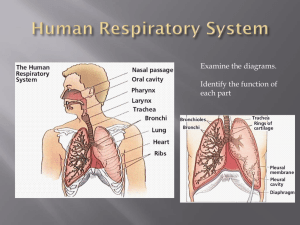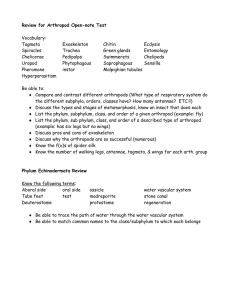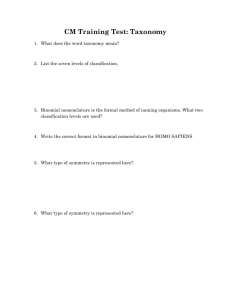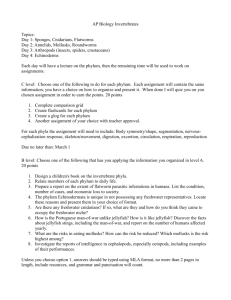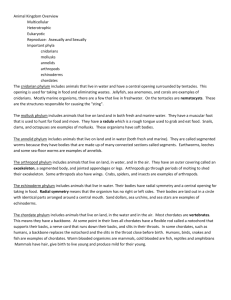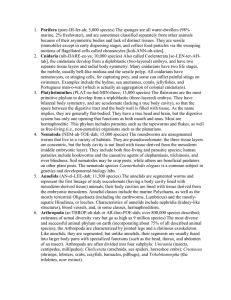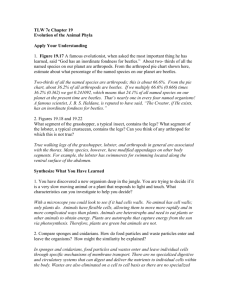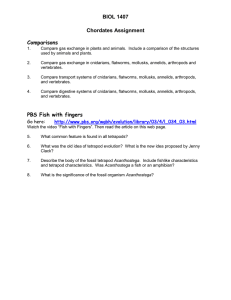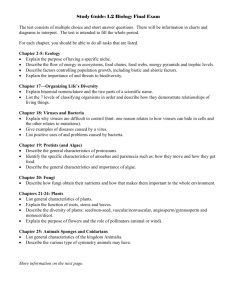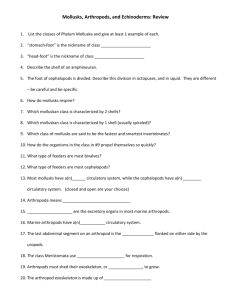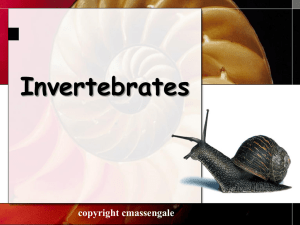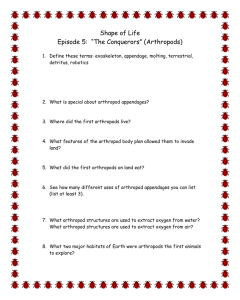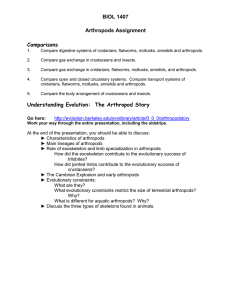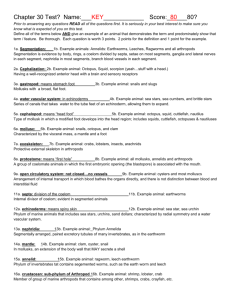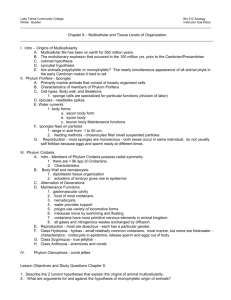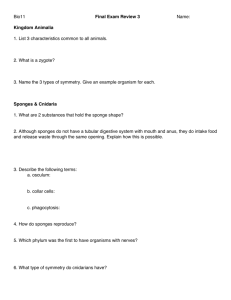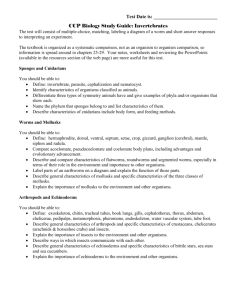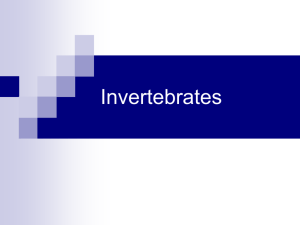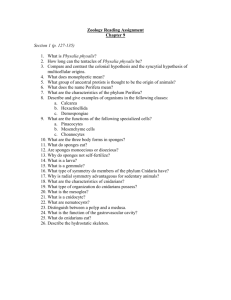Chaters 28
advertisement
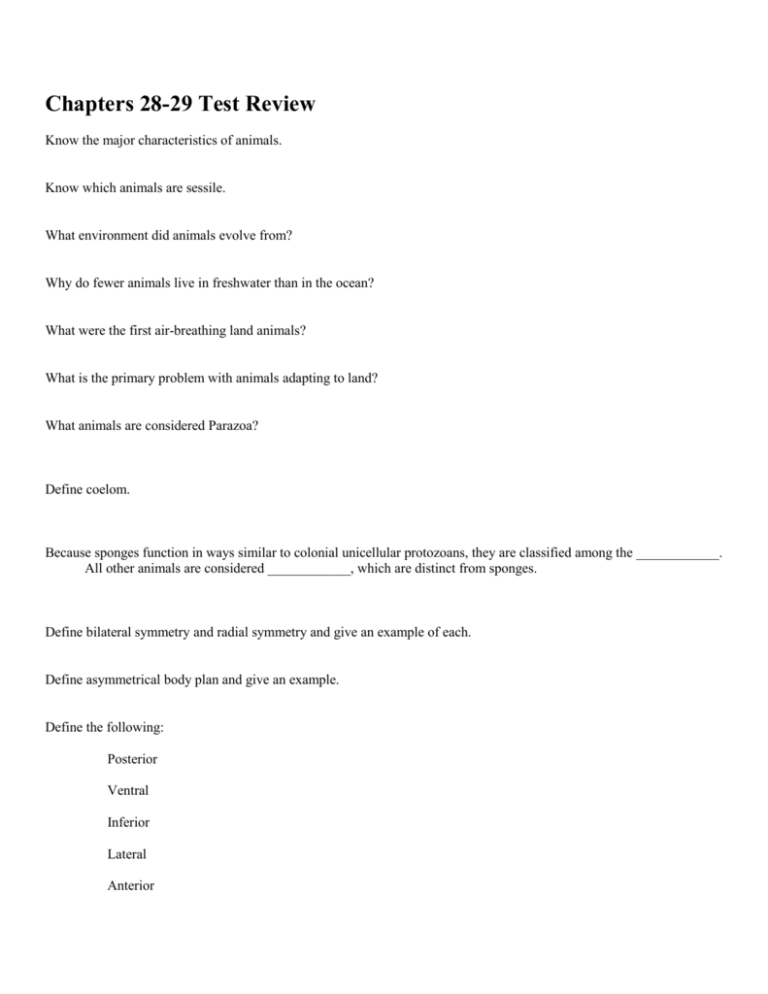
Chapters 28-29 Test Review Know the major characteristics of animals. Know which animals are sessile. What environment did animals evolve from? Why do fewer animals live in freshwater than in the ocean? What were the first air-breathing land animals? What is the primary problem with animals adapting to land? What animals are considered Parazoa? Define coelom. Because sponges function in ways similar to colonial unicellular protozoans, they are classified among the ____________. All other animals are considered ____________, which are distinct from sponges. Define bilateral symmetry and radial symmetry and give an example of each. Define asymmetrical body plan and give an example. Define the following: Posterior Ventral Inferior Lateral Anterior Describe the following planes: Median Frontal Sagittal Cross Transverse Define and know examples of each: Coelomate Pseudocoelomate Acoelomate Diploblastic Triploblastic Define and know which each gives rise to. Endoderm Ectoderm Mesoderm Diploblastic animals, such as cnidarians and ____________, have only two germ layers, ectoderm and ____________. What is the difference between protostomes and deuterostomes. Know with organisms are protostomes and which are deuterostomes. What characteristic cells to Sponges possess? Define hermaphroditic. From an evolutionary perspective, true nerve cells are first seen in what phylum? Know what organisms belong to each of the three classes in phylum Cnidaria. In cnidarians, nematocysts are housed in specialized cells, the ___________, located primarily on the tentacles. The larvae of some cnidarians are known as ____________ larvae. How do comb jellies move? The body wall of cnidarians and ctenophores consist of what layers. What are the two major groups of protostome coelomates? Define lophophore. Define cephalization state which organisms it was first seen. Define protonephridia. Like the cnidarians, flatworms depend on ____________ for achieving circulation and gas exchange. Figure 29-01 Use the figure below to answer the corresponding questions. Label and describe the function of each. Define a scolex. Define a proglotid. Ribbons worms have a unique ___________ that is used to capture prey. Define radula and state what phylum possess this structure. Where are most mollusks found. The veliger larval form is unique to what phylum What Mollusks have a closed circulatory system? How do bivalves feed? Define torsion and what animals possess this trait. Define parapodia. What is the main characteristic of Annelids? In both mollusks and annelids, the first larval stage is known as: Define parapodia and setae. Members of the class ________________ include blood-sucking parasites. The class __________ includes Lumbricus terrestris, the common earthworm. Why is segmentation is important in annelids? The ____________ of roundworms allows them to resist desiccation in terrestrial environments. ________________ are parasites that infect humans, and, as adults, reside in the small intestines of the host. A Trichinella infection is most common in persons who eat: The phylum name Arthropoda refers to: What are the main characteristics arthropods? What are the the disadvantages of exoskeletons in arthropods? The ___________ are very common arthropod Paleozoic fossils, and are extinct today. Members of the subphylum ________ lack antenna but possess unique mouthparts, which are not mandibles. Segmentation in arthropods differs from that of annelids because arthropod segments are: An arthropod with chelicerae, pedipalps, and silk glands would be: Arthropods with mandibles, a single pair of antennae, and two legs on most body segments are: As adults, ______________ are sessile crustaceans. What is thhe largest class of animals in terms of the number of different species is the class? What class do the horseshoe crabs belong to? What is one adaptation of insects that is specific to this group among all arthropods? What arthropod group is almost exclusively aquatic in habitat?
